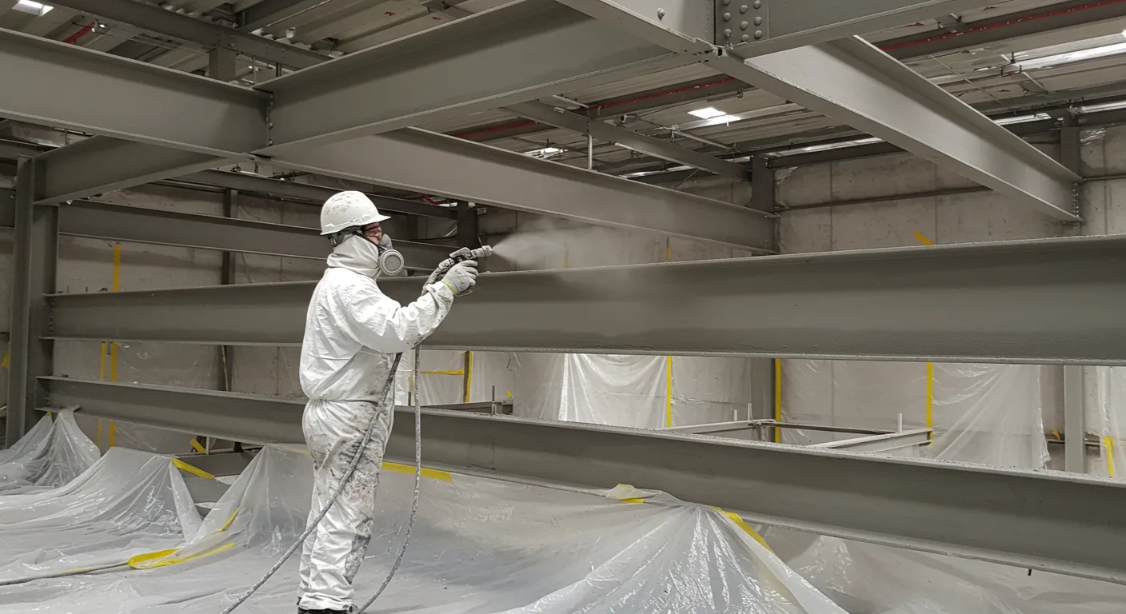At Foam Worx Insulation, we’re not just thinking about comfort we’re thinking about safety, longevity, and the unseen threats that can compromise the integrity of a home or building. Fire protection is one of those threats, and understanding how to stop fire before it spreads can make all the difference. That’s where intumescent paint steps in.
Intumescent coatings aren’t your average layer of paint. When exposed to high temperatures, they respond with a remarkable transformation, expanding into a thick, insulating barrier that helps keep surfaces structurally sound under fire stress. For property owners searching for effective passive fire protection, this isn’t a novelty it’s a practical necessity. And as insulation professionals with deep experience in fire-rated applications, we know exactly how to integrate these solutions where they matter most.
This guide explores how intumescent paint works, why it’s so effective, and how it fits into broader fire safety planning. We’ll walk you through what happens during a fire, how these coatings react in real time, and what to expect from properly applied systems — all from our hands-on perspective at Foam Worx Insulation. If you’re looking to better protect your property or meet code requirements without compromising aesthetics, this is for you.
What Happens When Intumescent Paint Meets Fire
Fire changes everything. In seconds, it can threaten structural integrity. That’s why building materials need more than just strength they need resilience under heat. Intumescent paint offers that resilience, activating only when it’s needed.
The Expansion Process: From Paint to Protective Barrier
Once the temperature hits around 350°F (177°C), the chemical compounds in intumescent paint kick into action. The coating starts to swell, forming a thick, foam-like char that can expand up to 50 times its original thickness. This layer acts as a thermal barrier, insulating the underlying surface from extreme heat.
This isn’t just puffed-up material. The charred layer slows down heat transfer to materials like steel or wood, buying precious time before they reach failure temperatures. That’s why we incorporate these paints in fire-rated assemblies particularly in areas where building code requires passive fire protection but traditional fireproofing methods aren’t practical.
Application Areas Where Foam Worx Uses Intumescent Coatings
At Foam Worx Insulation, we apply intumescent coatings in settings where direct fire exposure is a concern structural steel in basements, attic framing, load-bearing supports in commercial structures, and even retrofits in older properties. The goal: make sure the paint performs when it counts, without interfering with aesthetics or usability.
How Intumescent Coatings Enhance Fire Resistance Over Time
A key advantage of intumescent paint is its ability to remain dormant until needed. Unlike insulation that always performs passively, this material stores its full potential until activated by heat a delayed reaction that brings long-term durability without compromising space or design.
Long-Term Durability Without Ongoing Maintenance
When applied correctly with proper substrate preparation, coverage thickness, and environmental consideration these coatings remain effective for years. We’ve seen buildings ten years out from installation still benefit from the same degree of fire protection, thanks to stable chemical structures that resist moisture, UV, and everyday wear. For our clients, that means peace of mind without repeat labor or reapplication.
Ideal Pairings with Foam Insulation Systems
Intumescent paint isn’t a standalone fire safety solution it works best in harmony with other materials. That’s why we often pair it with closed-cell spray foam, which has inherent fire-retardant properties. Together, they create a layered system of defense: spray foam for energy efficiency and air sealing, intumescent coatings for passive structural protection.
Real-World Use Cases of Intumescent Paint in Construction
Every building presents a different fire risk profile. Homes have open framing, garages see higher combustion risks, and commercial spaces bring steel structures and open spans. We’ve applied intumescent coatings across all of these, using tailored techniques that adapt to both code and client priorities.
Residential Fire Protection That Blends with Aesthetics
In homes, exposed wood beams and attic spaces often need added fire resistance. Homeowners want safety, but not at the cost of design. Intumescent coatings let us treat these surfaces directly without altering the finish dramatically. The result: code-compliant protection without bulky wraps or obtrusive materials.
We’ve applied this approach in historic remodels, giving clients modern fire safety while preserving original architecture. It’s one of the few methods that works invisibly, which is a big win when appearance matters.
Meeting Fire Code for Commercial Structural Steel
In commercial builds, exposed structural steel is common but under fire, unprotected steel can lose its load-bearing capacity in minutes. We regularly apply intumescent coatings in these contexts to meet UL 263 and ASTM E119 fire resistance standards.
Our approach includes proper surface cleaning, primer selection, spray technique, and dry film thickness measurement. Every layer is about more than looks it’s part of a life-saving system. We work closely with contractors, inspectors, and project managers to ensure everything aligns with the project’s fire rating needs.
Benefits of Working with Foam Worx Insulation for Fire-Safe Coatings
Fire protection is high stakes. It’s not just about slapping on a coat of paint it’s about knowing how it works, when to use it, and how it integrates with other systems. That’s where our experience becomes your advantage.
On-Site Expertise With Fire-Rated Coating Applications
Our crews are trained to apply these coatings correctly factoring in humidity, material temperature, cure times, and film thickness. These aren’t DIY projects; performance depends on precision. We use high-grade equipment and reference manufacturer specifications every step of the way.
We also advise clients on placement when to prioritize intumescent coating over thermal barriers or vice versa. For attics, crawlspaces, garages, and load-bearing assemblies, we provide detailed assessments and application plans that comply with code and practical use.
Fully Integrated Insulation + Fire Protection Systems
We don’t treat fire protection as an afterthought. Our insulation services often include it from the beginning, allowing for better sequencing, tighter budget control, and more consistent coverage. When we combine intumescent coatings with closed-cell foam, we build comprehensive protection that covers energy efficiency and fire safety together.
Clients appreciate the streamlined process and results that last. Instead of hiring one contractor for insulation and another for coatings, Foam Worx Insulation delivers both saving time, reducing coordination issues, and simplifying inspections.
Still Curious? Let’s Dive Deeper with Foam Worx Insulation
1. Does intumescent paint really work in a fire?
Yes. It transforms under heat, expanding into a protective layer that slows down temperature rise on surfaces like steel or wood, helping maintain structural integrity during a fire.
2. How thick should intumescent paint be applied?
That depends on the fire rating required. We calculate dry film thickness based on building code requirements and manufacturer specifications for each job.
3. Is intumescent paint suitable for homes?
Absolutely. We apply it in attics, crawlspaces, and garages where fire resistance is critical often alongside spray foam insulation.
4. Can I paint over intumescent coating?
Some topcoats are compatible, but not all. We’ll recommend finishes that won’t interfere with expansion properties or fire performance.
5. How long does intumescent paint last?
When applied properly, it can last for decades. We’ve revisited projects after 10+ years and found performance still intact.
6. What’s the difference between intumescent paint and fire-retardant paint?
Fire-retardant paints delay flame spread. Intumescent paints swell and insulate surfaces from heat. We choose based on what the structure needs most.
7. Does intumescent paint replace drywall or fire-resistant panels?
Not always. It’s often used in conjunction with other materials for enhanced protection. We assess what’s needed to meet code and optimize cost.
8. Is it messy or disruptive to apply?
Not when done professionally. We use low-odor, low-VOC products and precise spray equipment. Most applications are quick and low-impact.
9. What surfaces can be coated with intumescent paint?
Steel, wood, and gypsum are common. We prep each surface properly to ensure adhesion and performance.
10. How do I know if my project needs intumescent paint?
Give us a call. We’ll evaluate the structure, local code, and your goals to determine if intumescent coating is the right choice.




